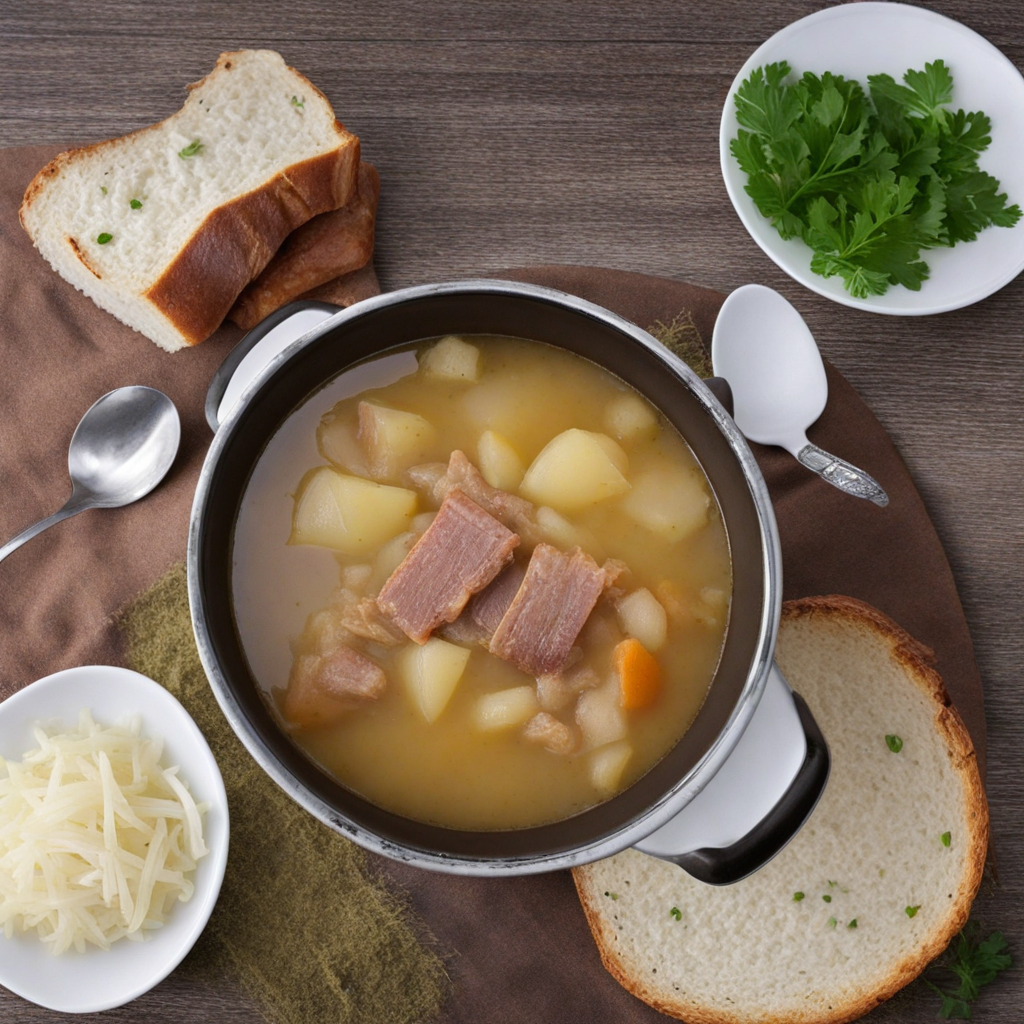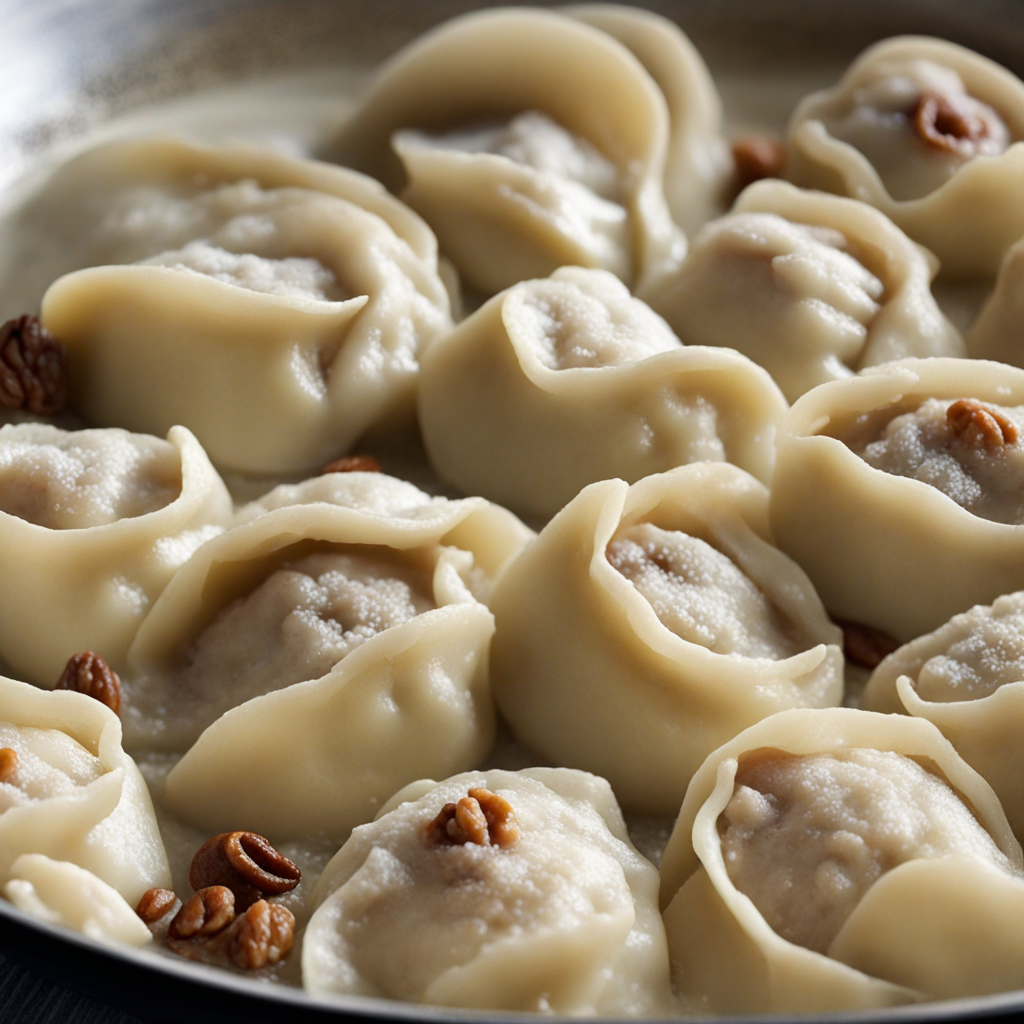Chicken Ptuj Style
Chicken Ptuj Style is a delightful Slovenian dish that showcases the rich culinary heritage of the Ptuj region. This dish features tender chicken pieces that are marinated in a mix of aromatic herbs and spices, including garlic, onion, paprika, and a hint of white wine. The combination of these ingredients creates a savory and slightly tangy flavor profile that enhances the natural taste of the chicken. Traditionally, the chicken is slow-cooked until it is succulent and infused with the fragrant marinade, making every bite a burst of flavor that transports you straight to the heart of Slovenia. Accompanying the chicken is a vibrant medley of seasonal vegetables, often featuring carrots, bell peppers, and potatoes, which are roasted to perfection. These vegetables not only complement the chicken's flavor but also add a colorful presentation to the dish. The use of local produce underscores the dish's commitment to fresh, regional ingredients, making it a wholesome and satisfying meal that reflects the essence of Slovenian cooking. To finish, Chicken Ptuj Style is often served with a side of polenta or crusty bread, allowing you to savor every last drop of the delicious sauce. The dish is typically garnished with fresh herbs, which elevate its appearance and aroma. Enjoying this meal is not just about tasting the food; it's about experiencing the cultural tales and traditions that have shaped Slovenian cuisine, making Chicken Ptuj Style a must-try for anyone looking to explore new culinary horizons.
How It Became This Dish
The History of Ptujčan Piščanec: A Culinary Gem from Slovenia Nestled in the picturesque valley of the Drava River, the town of Ptuj is one of Slovenia's oldest settlements, with a history stretching back to the Roman Empire. Among its many cultural treasures, one of the most noteworthy is the Ptujčan piščanec, or Ptuj chicken, a dish that embodies the region's agricultural heritage, culinary traditions, and the evolution of Slovenian gastronomy. #### Origins of Ptujčan Piščanec The origins of Ptujčan piščanec can be traced to the traditional farming practices that have characterized the Ptuj region for centuries. The fertile lands surrounding the town were ideal for raising poultry, particularly chickens, which became a staple source of protein for local families. This agricultural tradition, combined with the influence of various cultures that passed through the region—including the Romans, Slavs, and Austro-Hungarians—helped shape the culinary landscape of Ptuj. The Ptujčan piščanec is typically derived from indigenous breeds of chickens that are known for their hardiness and ability to thrive in the local climate. These birds are often raised in small family farms, where they are fed a natural diet of grains and foraged greens. This not only contributes to the chickens' unique flavor but also reflects the traditional Slovenian ethos of sustainable and ethical farming practices. #### Cultural Significance In Slovenia, food is more than mere sustenance; it is a reflection of identity and community. The Ptujčan piščanec holds a special place in local culture, often being served during significant family gatherings, celebrations, and festive occasions. It symbolizes hospitality and the warmth of Slovenian culture, where meals are an important way to bring friends and family together. The dish is also celebrated during local festivals, such as the Ptuj Carnival, where food plays a central role in the festivities. Here, the Ptujčan piščanec is often featured as a highlight, showcasing the region's culinary prowess. This connection to local traditions highlights how the dish has transcended its humble origins to become a symbol of cultural pride for the residents of Ptuj. #### Development Over Time The evolution of Ptujčan piščanec reflects broader changes in Slovenian society and culinary practices. In the early 20th century, the dish was typically prepared using simple, rustic methods—roasted or stewed with seasonal vegetables and herbs. These preparations emphasized the use of local ingredients and traditional cooking techniques passed down through generations. The focus was on enhancing the natural flavors of the chicken, relying on herbs such as thyme, rosemary, and garlic, which are abundant in the region. As Slovenia underwent significant political and social changes, particularly following World War II, the culinary landscape began to shift. The rise of industrial agriculture led to the availability of mass-produced poultry, which, while convenient, lacked the distinctive flavor and quality of the traditional Ptuj chicken. This change posed challenges for local farmers and traditional cooking practices, as the community grappled with the balance between modernity and tradition. Despite these challenges, the late 20th century saw a revival of interest in traditional Slovenian cuisine, driven by a growing awareness of sustainability, health, and the importance of preserving cultural heritage. Chefs and food enthusiasts began to rediscover regional dishes like Ptujčan piščanec, advocating for the use of locally sourced, organic ingredients. This resurgence of interest has led to the dish being featured in modern Slovenian restaurants, where chefs often put their own creative spins on the classic recipe while maintaining the essence of the original. #### Contemporary Interpretations Today, Ptujčan piščanec can be found in various forms across the region, reflecting both traditional and modern culinary influences. Contemporary chefs have embraced the dish, elevating it with innovative techniques while ensuring that it remains rooted in its cultural significance. From gourmet restaurants to family-owned eateries, Ptujčan piščanec is often prepared with a twist, incorporating flavors from global cuisines while celebrating its local heritage. Modern interpretations might include marinating the chicken in local wines, such as the famous Šipon or Cabernet Sauvignon from the nearby vineyards, or serving it with seasonal sides that highlight the region's agricultural bounty, such as roasted root vegetables or a fresh salad of locally sourced greens. Some chefs have even experimented with fusion dishes, combining the traditional Ptuj chicken with international flavors, creating a culinary dialogue that pays homage to its origins while appealing to contemporary palates. #### The Role of Festivals and Events The significance of Ptujčan piščanec extends beyond the dinner table; it plays a vital role in local festivals and events that celebrate Slovenian culture. The Ptuj Wine Cellar Festival, for example, often features the chicken as a centerpiece, showcasing its compatibility with the region's renowned wines. This festival not only promotes local gastronomy but also fosters a sense of community, as residents and visitors come together to celebrate their shared heritage through food and drink. Furthermore, the dish has become a symbol of Slovenia's culinary tourism efforts. As the country seeks to position itself on the global culinary map, traditional dishes like Ptujčan piščanec are being promoted as part of a larger narrative about Slovenia’s rich history and diverse culinary offerings. Visitors are encouraged to engage with local producers, learn about sustainable farming practices, and experience the authentic flavors of Slovenia, further solidifying the dish's place in the broader context of national identity. #### Conclusion The journey of Ptujčan piščanec from its humble beginnings in the fertile lands of Ptuj to its place as a cherished symbol of Slovenian culture is a testament to the power of food as a connector of people and traditions. As it continues to evolve, blending the old with the new, Ptujčan piščanec serves not only as a delicious culinary experience but also as a reminder of the importance of preserving cultural heritage in a rapidly changing world. Through its rich history, cultural significance, and ongoing development, Ptujčan piščanec stands as a delicious representation of Slovenian pride, inviting both locals and visitors alike to partake in a culinary tradition that has withstood the test of time. As Slovenia embraces the future, this delightful dish will undoubtedly continue to play a vital role in the nation's gastronomic narrative, celebrating the flavors, traditions, and stories that make it unique.
You may like
Discover local flavors from Slovenia







